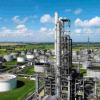Hi,
I am working in a liquefied ethane loading terminal. The liquid ethane from the storage tank is flowing through a 5,200 feet long pipe line before it feeds the ship. At the start up conditions, the pipe will be at the atmospheric temperature (105 F). The liquid ethane from the storage tank (downstream of the pump) is at -141 F and 65 Psig. This will enter a pipe which is at 105 F. Since the pipe is at the higher temperature, the ethane exit temp will be higher and may also form some amount of vapor. But this vapor rate will change from minute to minute as the pipe gets cooled down.
I want to know
- How long does it take to cool down the pipe completely to whatever the fluid outlet temp turns out to be?
- And also how much vapor will be generated during this period?
We are planning to send the vapor back to the storage tank, and the vapors from the storage tank will be compressed and send back to the storage tank itself. It is just a closed loop vapor recompression. I want to know the vapor generation rate to check whether my existing compressor can handle that rate. If not, the pressure in the tank will build up. Additional basic data are:
- Generally, these tanks operate at atmospheric pressure and can handle up to 1 Psig;
- This pipe line is having 6” of polyisocyanurate insulation;
- The wind velocity is 105 miles/hr;
- The ambient air temp is 105 F;
- The pipeline is a 24” stainless steel pipe (O.D: 24", I.D: 23.25");
- The liquid ethylene flowrate is 500,000 lbs/hr.
I guess for my calculation here I can ignore the insulation and the ambient temperature, because when the fluid enters 105 F pipe there won't be any heat transfer between the ambient and the ethane as it has the insulation. A method for hand calculation is appreciated; also let me know if there is a way to do this is Hysys. Let me know if you need any other info.
Thanks,
Chemico 822.
Edited by Chemico822, 15 November 2013 - 11:19 AM.

 FB
FB










